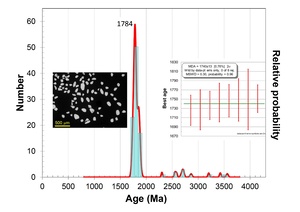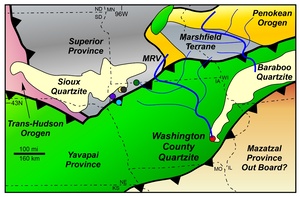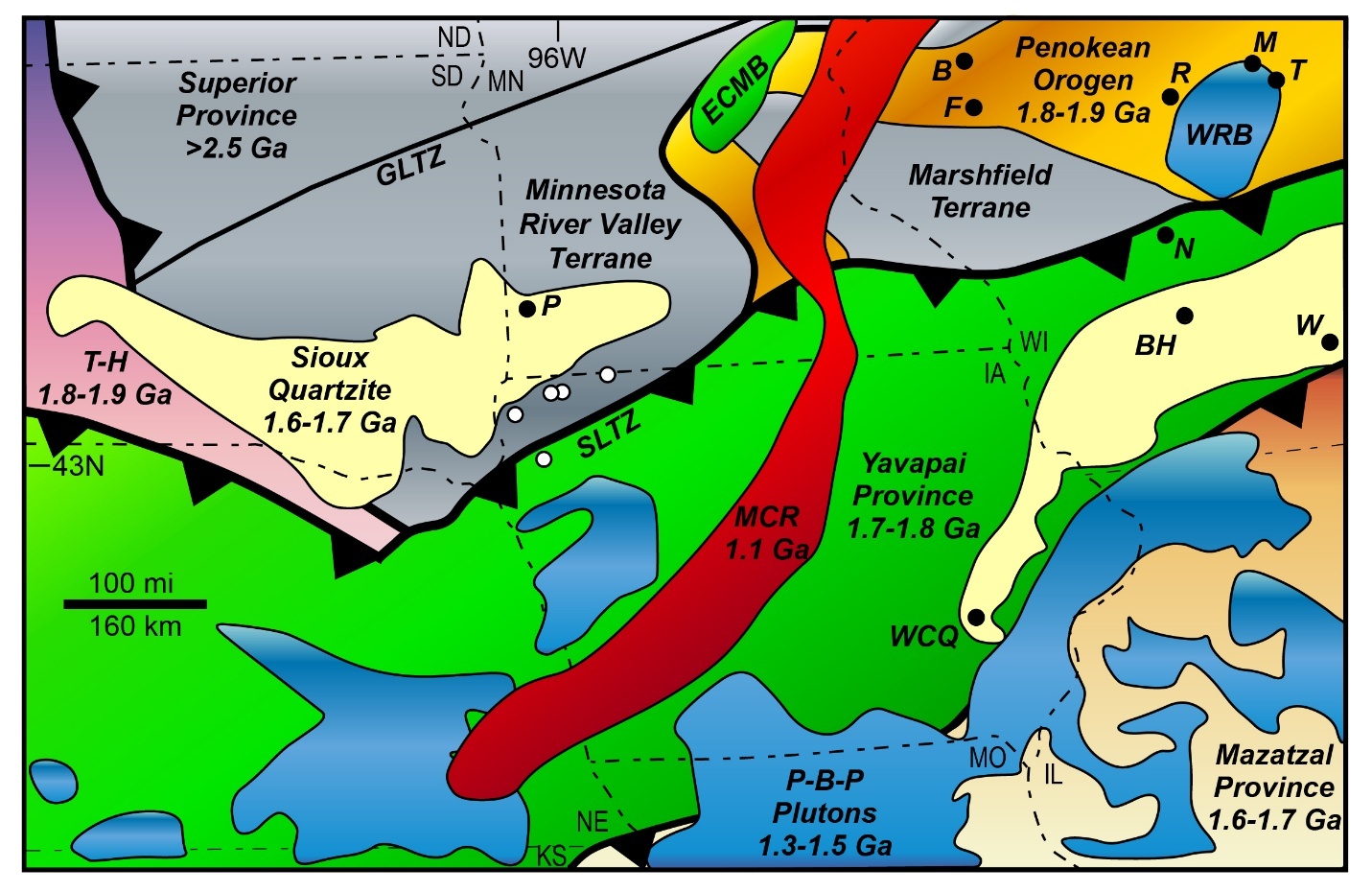Introduction
The Baraboo Interval denotes a significant period of sedimentation characterized by red colored siliciclastic deposits (Dott, 1983), with local thicknesses exceeding 1.5 km and an extensive coverage of over 300,000 km². This sedimentation occurred adjacent to the southern continental margin of Columbia supercontinent, following the Mazatzal orogeny and preceding the deformation and metamorphism linked to the Pinware-Baraboo-Picuris orogeny, which took place approximately 1.5 to 1.45 billion years ago (Bjørnerud, 2016; Craddock et al., 2025; Daniel et al., 2023; Malone et al., 2022; Medaris et al., 2021). The strata from this interval are crucial for understanding the Mesoproterozoic (Calymmian) development of Laurentia, including the timing of sediment deposition, the physiographic and climatic conditions during that time, and the sequence of folding and related metamorphic events. The Baraboo Interval strata were formed as a clastic wedge that thickens towards the south and are exposed as several inliers that rest unconformably atop Archean (>2.5 Ga), Penokean (1.9-1.8 Ga), and Yavapai (1.8-1.7 Ga) basement rocks (Figure 1). Paleocurrent data from the Baraboo Hills suggest a predominant transport direction towards the southeast (Dott, 1983). Comparable strata in terms of texture, composition, and age include the Sioux Quartzite found in eastern South Dakota and western Minnesota (Malone et al., 2022; Southwick et al., 1986), the Ortega Quartzite within the Hondo Group in northern New Mexico (Daniel et al., 2013; Jones et al., 2011), as well as the White Ledges, Four Peaks, and Del Rio quartzites in Arizona (Doe et al., 2012; Mako et al., 2015; Spencer et al., 2016). Other similar formations include the Athabasca Group in northern Alberta and Saskatchewan (e.g., Rainbird & Davis, 2007), the Dubawnt Supergroup located in the Thelon and Baker basins of Nunavut (e.g., Palmer et al., 2004), the Hornby Bay Group in the District of Mackenzie, Northwest Territories (e.g., Kerans et al., 1981), and the Belt-Windmere succession across Montana, Idaho, and southern Alberta (e.g., Link et al., 2013).
A critical part of the Baraboo Interval is the presence of a chemically evolved basal paleosol found across the region. Medaris et al. (2003, 2017) established that these units underwent enhanced chemical weathering to produce the supermature sedimentary characteristics. The mineralogical purity and a paucity of feldspar reflect an influx of first-cycle sediments and advanced chemical maturity. Geochemical analysis and quantitative estimates for weathering intensities during Baraboo deposition show Chemical Index of Alteration (CIA) values between 96 and 99, which indicate extreme chemical weathering during deposition.
Location and Background
During the early 1960’s, the occurrence of a stratigraphic high near the town of Keota in western Washington County, Iowa was indicated by subsurface geophysical anomalies and stratigraphic test drilling confirmed the presence of a structural dome or paleotopographic high (Figure 2). Two wells drilled in 1972 penetrated Proterozoic metasedimentary rocks at depths greater than 707 m (2,318 ft). These wells are located less than 2.4 km (1.5 mi) apart and reveal at least 150 m (500 ft) of relief along the Precambrian surface (Figure 2). A third exploration well was drilled south of Keota in 1990 and encountered quartzite at 760 m (2,490 ft). The extent and geometry of the occurrence is not well constrained, however the Keota Dome manifested as a structural feature produced by differential compaction of Paleozoic sediments over the rigid quartzite knob.
About 5 m (15 ft) of PQ (3 3/8 in) drill core was recovered from the center of the paleotopographic high in the W.F. Flynn M-1 (W-23148) well and the drill core are available at the Iowa Geological Survey (IGS; Figure 3). The well was later deepened to 770.5 m (2,528 ft), and drill cuttings indicate more quartzite is present beneath the recovered core without encountering crystalline basement. The upper 1 m of the Washington County Quartzite (WCQ) is green-gray phyllite with penetrating foliation dipping at 60 degrees from horizontal to core axis. Modal mineral constituents include up to 75% fine grained matrix of phyllosilicates (likely muscovite, pyrophyllite, sericite, and chlorite) as well as minor iron oxides (hematite) with the remaining 25% consisting of silt-sized polycrystalline and minor monocrystalline quartz (Figure 4). The presence of muscovite and pyrophyllite indicate the WCQ experienced greenschist facies metamorphism. Beneath the phyllite are phyllitic quartzite which appear conformable and gradational with the overlying phyllite. This unit has modal compositions of 15-50% phyllosilicate matrix and 50-85% fine sand-size particles of quartz, some of which have sutured boundaries and are weakly strained. The lowermost unit encountered in core is a pebbly quartzite with an appearance similar to other Baraboo Interval quartzites. Cross-beds with dips of as much as 70 degrees are evident. The dominance of coarse-grained over fine-grained clastic sedimentary units, the poorly sorted nature of the known stratigraphic succession, and the occurrence of ripple cross-laminae as well as cross-bedding with mud-draped foresets are consistent features found in fluvial-deltaic to marginal marine environments (Anderson & Ludvigson, 1986).
Although the WCQ is speculated to be part of the Baraboo Interval based on color, texture, composition, and structure, no objective geochronologic or geochemical data have been obtained. Recent studies have characterized the Baraboo Interval provenance (Daniel et al., 2023; Malone et al., 2022; Medaris et al., 2021; E. D. Stewart et al., 2018; E. K. Stewart et al., 2021; Van Wyck & Norman, 2004) and three distinct sediment sources are evident. The lower Baraboo Interval succession was derived from underlying Paleoproterozoic-Mesozoic basement rocks. The middle Baraboo Interval succession was derived from the Trans-Hudson orogen hinterland more than 2,000 km away. The upper Baraboo Interval succession was derived from Mazatzal terrane rocks <300 km to the south. The maximum age of deposition for these rocks is ~1640 Ma. The sedimentary and structural properties of the WCQ were previously described by Anderson and Ludvigson (1986), and while the poorly sorted nature of the deposit are interpreted as being terrigenous sourced sediments, the paleoclimate and intensity of chemical weathering during deposition of the WCQ were not defined. Our goal here is to characterize the sedimentary provenance, maximum depositional age, and determine the preservation of primary paleoweathering intensity of the WCQ. The WCQ is the southernmost occurrence of Baraboo Interval quartzites in the Laurentian midcontinent, occurring ~100-200 km from the presumed Yavapai-Mazatzal crustal boundary (Freiburg et al., 2020; Whitmeyer & Karlstrom, 2007). Thus, the WCQ provides valuable sedimentological and geochemical information along the distal reach of the extensive Baraboo Interval sand sheet.
Methods
Detrital Zircon U-Pb geochronology was conducted by laser ablation inductively coupled plasma mass spectrometry (LA-ICPMS) at the Arizona LaserChron Center. Please refer to the Element2 methodology at www.laserchron.org for the details of our analytical techniques. These U-Pb geochronology methods also have been described by Gehrels et al. (2008), Gehrels and Pecha (2014), and Sundell and Saylor (2021). A multidimensional scaling (MDS) plot was constructed with DZmds (Saylor et al., 2019). The maximum depositional age was calculated by taking the weighted mean of the youngest zircon population with overlapping ages (e.g. Dickinson & Gehrels, 2009; Malone et al., 2016). The details of the detrital zircon U-Pb data and analytical methodology are provided in the supplementary files.
All geochemical data herein, and additional results not reported, are open source and available on the IGS GeoSam well tracking database (Table 1). The methods used include Wavelength Dispersive X-Ray Fluorescence (WDXRF) and total digestion Inductively Coupled Plasma-Optical Emission Spectroscopy-Mass Spectroscopy (ICP-OES-MS) 61 element suite. Major element oxides were determined by WDXRF; the samples were fused with lithium metaborate/lithium tetraborate flux and the resultant glass disk was irradiated by an X-Ray tube. The data were considered acceptable if recovery of each major oxide was ±5% at five times the lower Limit of Determination (LOD) and the calculated Relative Standard Deviation (RSD) of duplicate samples was no greater than 5%. Sixty-one minor and trace elements were determined through ICP-OES-MS; samples were fused at 750°C with sodium peroxide then dissolved in diluted nitric acid, with the resulting solution being nebulized and delivered to the ICP. The excited atoms emit electromagnetic radiation wavelengths, which are measured by MS to determine elemental content. The data were deemed acceptable if recovery of each element is ±15% at five times the LOD and the calculated RSD of duplicate samples is no greater than 15%.
Results
Detrital Zircon Geochronology
Quartzite was sampled at a depth of 711 m (2,333 ft) and 100 zircons were analyzed. The detrital zircon age spectrum ranges from 3588-1726 Ma, with ~90% being Yavapai or Penokean in age. The principal age peak is 1784 Ma, which is the presumed age of the underlying Yavapai basement (Freiburg et al., 2020; Whitmeyer & Karlstrom, 2007). A secondary peak at ~1.85 Ga indicates that the Penokean terrane, which occurs ~200 km to the north, also supplied sediment to the WCQ. Archean zircons are also present, some of which are >3000 Ma in age, with sourcing from the Minnesota River Valley or Marshfield Archean terranes (Figure 5; Bickford et al., 2007; Craddock et al., 2018). The maximum depositional age, based on the 8 youngest grains with overlapping ages, is ~1740 Ma and supports the WCQ to have been deposited concurrent with the Baraboo Interval. Cumulative probability and MDS plots of complied Baraboo Interval detrital zircon datasets reveal a tripartite division of sediment sources (Malone et al., 2022). The WCQ is characterized by a dominate Yavapai-Penokean basement signature and shares a statistical likeness with other lower Baraboo Interval strata (Figure 6). The WCQ also plots near the Mud Lake and BARQ2 samples, which are middle Baraboo Interval. Both samples and the WCQ share a similar Archean signature where contributions converge in the 3200-2600 Ma age range, consistent with the ages of terranes in the southern Superior Province (Bickford et al., 1986; Schmitz et al., 2006).
Chemical Index of Alteration
During weathering, certain elements are mobilized and redistributed by various primary and post-deposition processes such as dissolution of original minerals, formation of secondary phases, transport of materials, co-precipitation, and ion-exchange of various materials. These processes are controlled by inherent factors such as solubility of parent material and redox potential, but external forcing, like induced pressure, temperature, and strain also lead to progressive breakdown of rock. Fine-grained siliciclastic sediments may be evaluated using the Chemical Index of Alteration (CIA; Nesbitt & Young, 1982) to determine the intensity and degree of weathering. The CIA is defined as: [Al2O3/( Al2O3+CaO*+Na2O+K2O)]x100. The oxides are converted to molar proportions and CaO* is corrected for the presence of apatite (P2O5) to account for non-silicate Ca. The CIA characteristics are illustrated by A-C*N-K ternary plots, where the weathering trend follows a vector from the protolith to the A-K line which represents the progressive removal of plagioclase. Once the weathering vector reaches the A-K join, further weathering proceeds towards the A apex with additional removal of K-feldspar and decreasing K/A ratio.
There are many difficulties with measuring CIA in Proterozoic metapelites due to post-deposition deformation, metamorphism, and metasomatism, which alter the original weathered compositions due to sediment interactions with hydrothermal alkali pore waters (Fedo et al., 1995; Medaris et al., 2003, 2015). Two samples of phyllite and phyllitic quartzite were analyzed from the WCQ, and measured CIA values are 72 and 75 (Figure 7). The pre-metasomatic CIA value can be estimated from an A-C*N-K plot by drawing a line from the K apex through the WCQ samples and intersect the idealized weathering vector of granite protoliths which runs subparallel to the A-C*N join (Fedo et al., 1995; Medaris, 2015). This intersection determines the pre-metasomatic CIA value and following this procedure for the WCQ samples, the CIA values increase to 86 and 87. These values are lower than published weathering intensities measured from other Baraboo Interval strata but still indicate extreme levels of chemical weathering (Medaris et al., 2003, 2017).
Due to the crystalline basement directly beneath the WCQ not being penetrated, the depth to, and composition of the weathered protolith is unknown. However, the protolith can be inferred from DZ provenance which indicates local-proximal sediment sourcing. No comparable basement rocks have been dated in the vicinity of the WCQ, so protolith compositions are assumed from five other Precambrian granitic units in northwest Iowa. All samples have crystallization ages which are admissible as being potential weathered sources of the WCQ (Van Schmus et al., 1987; Windom et al., 1993). An average Iowa granite composition is assumed the best fit for an original unaltered protolith. Major mobile and immobile elements (K, Ca, Mg, Fe, Al, Si, Ti) were normalized to Upper Continental Crust (UCC) values (Taylor & McLennan, 1985) and plotted to compare relative addition and depletion between WCQ and protolith elemental compositions (Figure 7). Moderate enrichment of K, Al, and Ti in the WCQ relative to potential unaltered granite sources, and depletions in Ca and Si is evident for the WCQ.
An isocon diagram (Grant, 1986) is a quantitative method used to evaluate the chemical change of component concentrations caused by alteration processes. By plotting the weathered rock against the unaltered protolith, unchanged components will fall along a straight line originating from the 0.0 intercept and Al2O3, the “isocon”, the slope of which (y=1.698x) defines the change in mass as a result of alteration. Al2O3 is assumed the best monitor for metasomatic mass transfer because of its immobile behavior and abundance. Deviation from this line indicate a change in concentration for a given component. Application of this method for the average WCQ sample and average Iowa granite indicate stable concentrations of Al2O3 and Zr, accompanied by a mass decrease of ~41% (Figure 7). Alteration of the WCQ effectively removed all CaO (~98%) and Na2O (~97%), and substantially reduced SiO2 (~52%), MgO (~40%), Fe2O3 (~42%), Ba (~42%) Sr (~55%), while incorporating significant increases in TiO2 (~34%), K2O (~41%), and Rb (~128%).
Discussion
The WCQ detrital zircon age spectrum is statistically similar to data from the lower Baraboo interval strata present in Wisconsin, which is largely derived from local crystalline basement sources. The presence of Archean zircons and a slight affinity with several middle Baraboo Interval units affirms a lesser distally derived component from the north. Despite being near the Yavapai-Mazatzal terrane boundary, no Mazatzal zircons are present, which are abundant in uppermost Baraboo strata further north (Medaris et al., 2021). Thus, the Mazatzal terrane highlands were either not yet uplifted as a prominent sediment source or were still outboard.
Post-deposition alteration of the WCQ resulted in elemental remobilization and corresponding mass change. A mass increase of TiO2 and an abundance of Al2O3 relative to inferred protolith compositions can be attributed to the primary influx of detrital sediments, such as rutile and phyllosilicates, which remained constant during later alteration. It is also possible that the protolith of the WCQ was a peraluminous leucogranite that contributed an excess of alumina and titanium, however that is not representative of the average granite composition from northwest Iowa. The high concentration of K2O and Rb suggest some later introduction of these components and is attributed to the well-known Geon 14 K-metasomatism which altered the original kaolinite to illite, muscovite, pyrophyllite, and sericite (Daniel et al., 2023; Medaris et al., 2003, 2021).
The calculated pre-metasomatic CIA values for the WCQ is 86 and 87, which is lower than the established values in the outcrop region (Medaris et al., 2003, 2017). There are several explanations for this discrepancy. First, the WCQ experienced potassium addition by Geon 14 metasomatism, which displaced the pre-metasomatic composition towards the K apex. The calculated pre-metasomatic K2O (K2Ocalc) composition is 3.2 wt%, representing a ~110% increase in K2O post deposition (Fedo et al., 1995). The alternative explanation is that the WCQ experienced lower chemical weathering intensities compared to the Baraboo Interval elsewhere, potentially due to limited subaerial weathering along the margin of Laurentia or a local source of sediments without long distance transport. The authors favor the latter explanation due to the local sourcing of sediments revealed by detrital zircon provenance.
Conclusions
The depositional model that we favor is one of marginal marine-terrestrial dominance, with sediment sourcing from proximal areas no more than a few hundred kilometers to the north. Proximal deposition of lowermost Baraboo Interval strata is evident throughout the region (Figure 8; Malone et al., 2022). The MDA for the WCQ is 1740 Ma and predates Mazatzal orogenic magmatism. Pre-metasomatic CIA values are >80, indicating an extreme chemical weathering intensity during WCQ deposition. These CIA values are lower than those of other Baraboo Interval localities, which indicate spatiotemporal variations in weathering intensity, attributed to locally derived sediments with relatively short transport distances.
Acknowledgements
EAR2050246 supported the Arizona LaserChron Center operations. Whole rock geochemical analyses were performed by SGS Laboratories under contract from USGS as part of the Iowa Geological Survey Data Preservation Priority 3 FY23 grant G23AP00280. All geochemical data and complementing metadata are open source and available on the IGS GeoSam well tracking website https://www.iihr.uiowa.edu/igs/geosam/.


_total_magnetic_intensity_map__u.s._geological_survey__y_493154__with_precambrian_surfa.jpeg)
_.jpeg)
_p.jpeg)


_multidimensional_scaling_plot_in_three-dimensional_space_of_detrital_zircon_u-pb_age_s.jpeg)
_normalized_upper_continental_crust_ratios_for_select_components_from_the_washington_co.jpeg)


_total_magnetic_intensity_map__u.s._geological_survey__y_493154__with_precambrian_surfa.jpeg)
_.jpeg)
_p.jpeg)


_multidimensional_scaling_plot_in_three-dimensional_space_of_detrital_zircon_u-pb_age_s.jpeg)
_normalized_upper_continental_crust_ratios_for_select_components_from_the_washington_co.jpeg)
